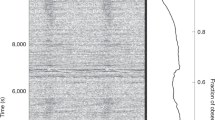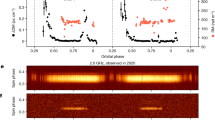Abstract
DURING a survey of the southern sky for millisecond pulsars, we have discovered one with by far the greatest flux density of any known millisecond pulsar, often exceeding 1 Jy at 430 MHz. The dispersion measure (integrated electron density along the line of sight) is the smallest for any known pulsar. This object, PSR J0437–4715, may be the closest known pulsar, and is several times closer than any other known millisecond pulsar. Its rotation period is 5.75 ms, and it is in a 5.7-day circular orbit with a low-mass companion. The spin-down energy flux density is the third highest known, after the Crab and Vela pulsars. These properties make possible studies of the pulsar at radio wavelengths with unprecedented detail, and indicate that it should be possible to detect both the pulsar and its companion at optical and perhaps shorter wavelengths.
This is a preview of subscription content, access via your institution
Access options
Subscribe to this journal
Receive 51 print issues and online access
$199.00 per year
only $3.90 per issue
Buy this article
- Purchase on Springer Link
- Instant access to full article PDF
Prices may be subject to local taxes which are calculated during checkout
Similar content being viewed by others
References
Bailes, M. et al. Astrophys. J. (submitted).
Wolszczan, A. Nature 350, 688–690 (1991).
Wolszczan, A. & Frail, D. A. Nature 355, 145–147 (1992).
Nice, D. J., Taylor, J. H. & Fruchter, A. S. Astrophys. J. (submitted).
Johnston, S. & Bailes, M. Mon. Not. R. astr. Soc. 252, 277–281 (1991).
Taylor, J. H. & Cordes, J. M. Astrophys. J. (submitted).
Johnston, S. et al. Mon. Not. R. astr. Soc. 255, 401–411 (1992).
Taylor, J. H. & Weisberg, J. M. Astrophys. J. 345, 434–450 (1989).
Foster, R. S., Fairhead, L. & Backer, D. C. Astrophys. J. 378, 687–695 (1991).
Rankin, J. M. Astrophys. J. 274, 333–358 (1983).
Lyne, A. G. & Manchester, R. N. Mon. Not. R. astr. Soc. 234, 477–508 (1988).
Bhattacharya, D. & van den Heuvel, E. P. J. Phys. Rep. 203, 1–124 (1991).
Callanan, P. J. et al. Mon. Not. R. astr. Soc. 238, 25p–28p (1989).
Kulkarni, S. R., Djorgovski, S. & Klemola, A. R. Astrophys. J. 367, 221–227 (1991).
Kulkarni, S. R. Astrophys. J. 306, L85–L89 (1986).
Koester, D., Chanmugam, G. & Reimers, D. Astrophys. J. 395, L107–L110 (1992).
Shapiro, S. L. & Teukolsky, S. A. Black Holes, White Dwarfs and Neutron Stars. The Physics of Compact Objects (Wiley-lnterscience, New York, 1983).
Iben, I. & Tutukov, A. V. Astrophys. J. 282, 615–630 (1984).
Fruchter, A. S., Gunn, J. E., Lauer, T. R. & Dressler, A. Nature 334, 686–689 (1988).
Ryba, M. F. & Taylor, J. H. Astrophys. J. 371, 739–748 (1991).
Salter, M. J., Lyne, A. G. & Anderson, B. Nature 280, 477–478 (1979).
Gwinn, C. R., Taylor, J. H., Weisberg, J. M. & Rawley, L. A. Astr. J. 91, 338–342 (1986).
Bailes, M., Manchester, R. N., Kesteven, M. J., Norris, R. P. & Reynolds, J. E. Nature 343, 240–241 (1990).
Bhattacharya, D. & Srinivasan, G. J. Astrophys. Astr. 12, 17–25 (1991).
Bailes, M. & Kniffen, D. A. Astrophys. J. 391, 659–666 (1992).
Thompson, D. J. et al. Nature 359, 615–616 (1992).
Harding, A. K. Astrophys. J. 245, 267 (1981).
Cheng, K. S., Ho, C. & Ruderman, M. Astrophys. J. 300, 500–521 (1986).
Author information
Authors and Affiliations
Rights and permissions
About this article
Cite this article
Johnston, S., Lorimer, D., Harrison, P. et al. Discovery of a very bright, nearby binary millisecond pulsar. Nature 361, 613–615 (1993). https://doi.org/10.1038/361613a0
Received:
Accepted:
Issue Date:
DOI: https://doi.org/10.1038/361613a0
This article is cited by
-
A dynamically discovered and characterized non-accreting neutron star–M dwarf binary candidate
Nature Astronomy (2022)
-
Spectral Constraints for Millisecond Pulsars Due to General Relativistic Frame Dragging
Astrophysics and Space Science (2005)
-
A test of general relativity from the three-dimensional orbital geometry of a binary pulsar
Nature (2001)
Comments
By submitting a comment you agree to abide by our Terms and Community Guidelines. If you find something abusive or that does not comply with our terms or guidelines please flag it as inappropriate.



